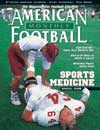Article CategoriesAFM Magazine
|
The ProtectorTampa Bay\'s Todd Toriscelli is in charge of caring for everything from nutrition to critical care for Buccaneer players.by: Jane Musgrave © More from this issue When Tampa Bay Buccaneers defensive back Damien Robinson is asked how important athletic trainers are to his game, he whips out his cell phone. "He is the No. 1 number," Robinson says of Bucs head trainer Todd Toriscelli. Once thought of as those guys who toted water or taped ankles, athletic trainers are now as important to winning football programs as quarterbacks with cannons for arms or receivers who can sprint downfield undetected to catch those powerful blasts. "I think the importance of our profession has really increased as the competition in the NFL and college programs has increased," says Toriscelli. "Seasons are made on who they lose and who teams keep. It becomes a battle of attrition." And after spending more than a decade on the front lines in both professional and college football, Toriscelli knows a....The full article can only be seen by subscribers.
|
|
|||||||
| HOME |
MAGAZINE |
SUBSCRIBE | ONLINE COLUMNISTS | COACHING VIDEOS |
Copyright 2025, AmericanFootballMonthly.com
All Rights Reserved





